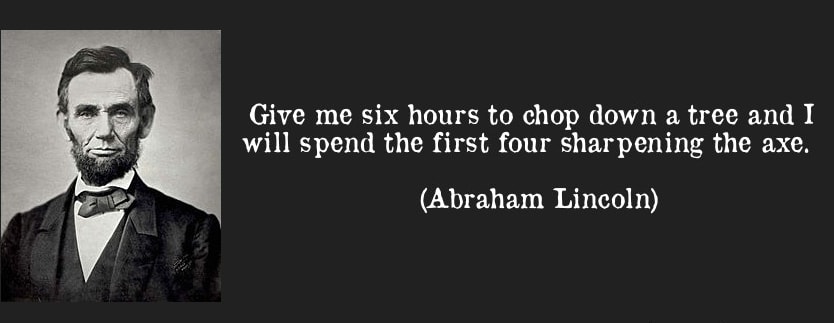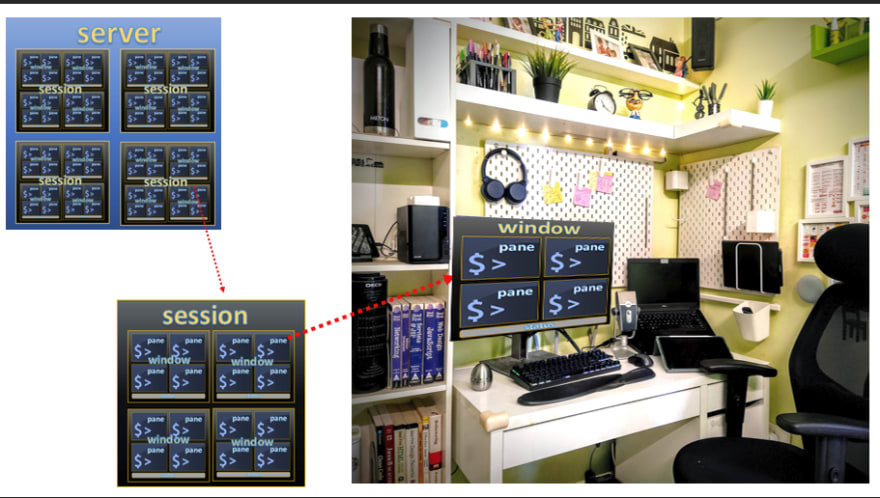Who Should Read It:
- Anyone who uses the command line daily and not yet explored tmux in-depth, this blog is for you.
- If you are already using tmux, check out 'beyond basics' section.
- Others, check out the 'why should you care' section to see if it can be a valuable addition to your toolbox.
You do not really need this blog to use tmux; If you want a technical guidebook, you could look at the manpage for tmux. However, manpages are seldom adequate to wrap your brain around concepts (why & when); they're there for reference (how-to) sorted alphabetically instead of logically. Here, We will see 'why tmux', some of its practical uses, and how to quickly start using it in your day-to-day workflow.
Why Should You Care
Suppose you are working on many projects or many contexts (DevOps, development, exploring, etc.). In that case, each needs a set of terminals to control various activities, "creating more tabs & windows and using a mouse to organize them" isn't the best solution. This process is typically slow, and the context-switching between different kinds of work is very unproductive (especially if you end up redoing the same setup afresh).
Of course, there are other ways of managing multi-tasking, like using simple bg & fg commands or using the GNU screen. However, Tmux is considered to be the next evolutionary step forward. I am not overstating; even the screen packages have been replaced by tmux in RHEL8.
"T"erminal "mu"ltiple"x"ing
I am writing this in a github-managed .md file from vim running in a pane, inside a window, in a session managed by a tmux server, through a client running in my zsh terminal in Ubuntu VM using VirtualBox that installed in win10.
Tmux is a powerful tool; It is one of those things that at first sounds peculiar, involved and intensive; you can't quite grasp what the heck they do, how they can be valuable or why anybody even wants to use them. Nonetheless, it is one of those things that will turn out to be a fantastic swiss-army-knife when given a chance. Let's give a chance for the below reasons.
Why Tmux?
tmux help solves the weaknesses of standard terminal emulators. The followings are some of the reasons why I became a tmux fan:
- It expedites the creation and management of terminal windows and pane
- Once you get familiarized with working within sessions, windows, panes, you are into an excellent developer environment.
- It provides the ability to connect to existing local and remote sessions
- It uses a client-server model, which lets you pause and resume your work where everything is exactly how you left it.
- It makes it easy for context-switching between multiple themes of your work
- It is totally customizable and gives the ability to automate creating a specific layout
- It comes with the heavy load of built-in commands that let you build your script to automate your dev env
- It provides 100% mouse-free control
Overall, it can be an incredible productivity booster once you get the hang of it.
Basics
Ok, Let's break down tmux by its objects, from servers down to panes.
- Server is what powering tmux behind the scenes. It is so streamlined, and zero-config needed from you. It runs in the background; you will hardly notice it is there. When you execute a tmux command, a tmux server is launched. Every activity that is launched in the tmux happen within the server. What you see in your shell is merely a client connection. The server holds sessions.
- Session is essentially the base unit holding windows. You can have multiple sessions also. e.g., you could have one session for each application your developing or a session for work and a session for your cool side project or exploration.
- Window is what you see when tmux is open in front of you. Think of it as a tab in your browser. The window layout is customizable, and tmux has many preset layouts also to arrange panes.
- Panes are a terminal in a terminal, or you could call it pseudoterminals. The panes let you divide the screen horizontally and vertically within the same window. A window and a pane are perfect analogies to their real-world counterparts.
Sessions, Windows & Panes: These are good to logically organize multiple activities (totally mouse-free).
I think we got the basic concepts covered. Now, Let's see the general usage of the tool in the context of typical dev workflow.
Typical Workflow
This flow is how tmux-using developers' day looks like. First things first, one grabs a coffee ☕ and bossily command GoogleHome to play Mozart 🎵 on Spotify. Then, let's say that we are starting the work on project A.
-
Step 1: You can start just by invoking
$ tmux. However, I suggest that you always begin by creating a session with a name; it is better than a default session name. The name could be the project or a theme you are working on, so it will be easy to recognize and switch between them.
$ tmux # Launch tmux with defalut session
$ tmux new-session –s # Launch tmux with a named session
*[prefix] X Closing Session
# By default, all key bindings will require a "prefix" key before they are active. It is like a <leader> key in vim. The default is Ctrl-b; I changed to Ctrl-a.
* this is a custom key-binding
- Step 2: Now, You can create as many panes as needed (typically, the most user go with three panes in a window; one editor in the main terminal and two other terminals for running processes like interacting with git, running tests, a web server, etc.…)
#### Pane Management
*[prefix] _ Split the window into two vertical panes
*[prefix] | Split the window into two horizontal panes (horizontal )
[prefix] q Show the pane number in each pane briefly.
[prefix] arrow-keys Switch focus to different pane
C-d Close the pane just like how you will close a terminal
#### Layout Management
[prefix] <space> Rotate through the default layouts
[prefix] <alt>1 Switch to Even Horizontal Layout
[prefix] <alt>2 Switch to Even Vertical Layout
[prefix] <alt>3 Switch to Main Vertical Layout
[prefix] <alt>4 Switch to Main Horizontal Layout
[prefix] <alt>5 Switch to Tiled Layout
### Resizing Panes
[prefix] z zoom current pane to full window size
[prefix] <ctrl>up increase the height of this pane by one row
[prefix] <ctrl>down decrease the height of this pane by one row
[prefix] <ctrl>left increase the width of this pane by one column
[prefix] <ctrl>right decrease the width of this pane by one column
*[prefix] H increase the height of this pane by two row (shift+)
*[prefix] J decrease the height of this pane by one row
*[prefix] K increase the width of this pane by one column
*[prefix] L decrease the width of this pane by one column
[prefix] <alt>up increase the height of this pane by five rows
[prefix] <alt>down decrease the height of this pane by five rows
[prefix] <alt>left increase the width of this pane by five columns
[prefix] <alt>right decrease the width of this pane by five columns
*this is a custom key-binding
- Step 3: Then, you start working, 🎵click-clack clickity-clack🎵, while you'r at it, if a single window can't hold all related terminal works, you can create additional windows as you see fit.
Frequent Use:
[prefix] c _C_reate a new window
[prefix] , Rename current window
[prefix] w Choose a _w_indow from a menu
[prefix] 0-9 Switch to window 0-9
[prefix] p Cycle to _p_revious window
[prefix] n Cycle to _n_ext window
[prefix] l Back to the _l_ast window
[prefix] x Closing Window
Sporadic Use:
[prefix] M-p _p_revious window with activity
[prefix] M-n _n_ext window with activity
[prefix] ! Breaking Window Panes If you have too many panes in a single window.
$ move-window –t {target session} # Move the window from one session to another
$ link-window –t {target session} # Link a window between two sessions
$ unlink-window # Unlink the window from the current session
$ join-pane -t {session}:{window} # Join the current pane to a target window
- Step 4: Then, you just realized that you need to finish off something for project B; now, you can create a new session for project B and switch out from the first session. You can come back to project A workspace later (maybe tomorrow or next year as long as your tmux server runs).
[prefix] s Choose from a list of _s_essions
[prefix] ( Switch to previous session
[prefix] ) Switch to next session
[prefix] L Switch the attached client back to the _L_ast session.
[prefix] $ Rename the session
- Step 5: When it is closing time, you could leave the working session open or detach the session. When you detach a session, it becomes a headless entity running in the background and remain active in the server, ready for whenever you want to resume the work. You can even close the terminal that launched it.
[prefix] d _d_etach from your current session
- Step 6: The next day, when you reconnect, you can start a new terminal and reattach the still-running background session that contains your work in progress. Tada! You just jumped right back in. Now, you can start making your keyboard sing again 🎵.
$ tmux attach-session -t {session-name} # Start tmux and attach a _t_arget session by name
Beyond Basics: Personalizing Environments & Scripting tmux
With the basics under our belt, let's explore a custom configuration and automation of developer workspace in part two of this blog. It will wrap up with valuable tricks you can use with tmux to improve your day-to-day development. For the Impatient, you could check out my tmux setup here -github
tmux is a versatile addition to your terminal toolbelt. No need to grasp everything in a single sitting; efficiently managing workspace with tmux is a skill acquired over a period. Soon you will find yourself becoming more comfortable with this powerful screen-management tool.
<<à suivre...>>








Top comments (1)
Tmux man page is big and has little examples, but this is a very good and useful information selection. Thanks!